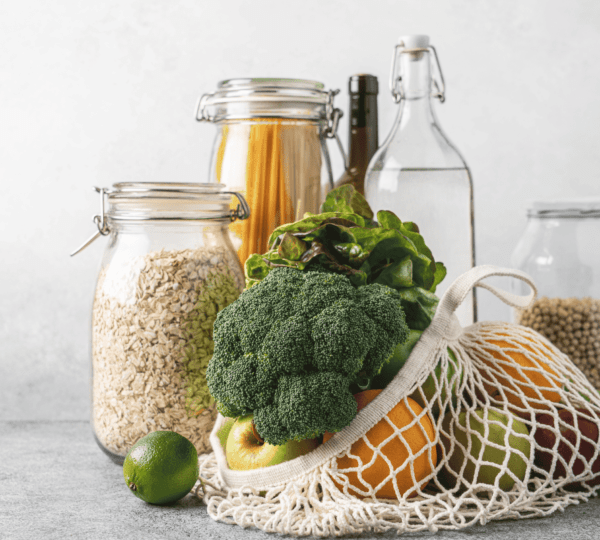
Implementing a Zero-Waste Kitchen: A Comprehensive Guide to Reducing Food Waste and Environmental Impact
Before I became aware of the concept of a zero-waste kitchen, I remember opening my fridge one evening and being hit by a sour smell. My heart sank as I hesitantly pulled out the culprit. Tucked behind a carton of milk was an unopened bag of salad greens, now mushy and rotten. Right next to it was a container of leftovers I had completely forgotten about.
It wasn’t the first time I’d dealt with wasted food. With each toss into the trash, I realized I wasn’t just throwing away food but also the money I’d spent, the time I’d invested in planning meals, and the environmental impact of my waste. It all seemed so wasteful, and deep down, I knew there had to be a better way.
But what if I could change this pattern? What if I could create a kitchen where nothing goes to waste—where every piece of food is used efficiently, and my trash bin is practically emptyof spoilt food at the end of the week? That’s when I discovered the concept of a zero-waste kitchen, a lifestyle that not only reduces environmental impact but also saves time and money in the long run. It seemed like the perfect solution to the problem I hadn’t even fully realized I had.
What is a Zero-Waste Kitchen?
A zero-waste kitchen is all about making conscious choices to reduce food waste and cut down on single-use plastics. It involves careful planning, shopping with intention, and learning to use every part of the ingredients you buy. The concept extends beyond merely avoiding waste; it encourages creativity, sustainability, and a mindful approach to food. It’s not just a trend; it’s a sustainable way of living that can help address the larger issue of food waste, which, according to the Food and Agriculture Organization (FAO), accounts for one-third of all food produced globally.
Why Zero Waste Matters
Food waste is a significant issue with far-reaching consequences. According to the Environmental Protection Agency (EPA), food waste is the largest component of landfills, where it produces methane, a potent greenhouse gas that contributes to climate change. By reducing food waste in your kitchen, you are directly contributing to lowering your carbon footprint. A zero-waste kitchen also combats the overuse of plastics, which often end up polluting oceans and harming wildlife.
Dr. Jennifer Martin, a sustainability expert and author of Green Living, Today and Tomorrow, emphasizes the importance of this lifestyle: “Implementing a zero-waste lifestyle, starting in the kitchen, is one of the most impactful steps an individual can take to reduce their environmental footprint.” By adopting these practices, you are not only improving your immediate surroundings but also playing a part in a global movement toward sustainability.
Step-by-Step Guide to Implementing a Zero-Waste Kitchen
1. Start by Taking Inventory
Before heading out to shop for groceries, take a look at what you already have. One of the leading causes of food waste is purchasing duplicates or items you don’t need. A simple way to avoid this is by organizing your pantry and fridge, keeping track of expiration dates, and planning meals based on what you already have.
Use apps like CozZo or Pantry Check to help manage your pantry inventory and expiration dates. These apps allow you to scan items, set reminders, and plan meals based on what you already own, helping you reduce the risk of forgetting about perishables.
2. Plan Your Meals
Meal planning is key to a zero-waste kitchen. By knowing exactly what meals you’ll prepare for the week, you can avoid buying unnecessary ingredients and ensure that everything you purchase has a purpose. This practice not only minimizes waste but also saves you time during busy weeknights.
Plus, meal planning allows you to get creative with leftovers, reducing waste even further. Consider themes for certain nights, such as “Meatless Monday” or “Throwback Thursday” to repurpose leftovers creatively.
Make a shopping list and stick to it. Impulse buying often leads to wasted food and unnecessary packaging. Stick to seasonal produce to not only save money but also enjoy fresh, flavorful ingredients.
3. Shop Smart
When it’s time to shop, think about packaging. Bring your own reusable bags, produce bags, and containers to avoid plastic packaging. Many grocery stores now offer bulk sections where you can buy items like grains, beans, and nuts without packaging. If you don’t have access to a bulk section, opt for items with minimal or recyclable packaging.
According to Tara McKenna, founder of The Zero-Waste Collective, “Shopping in bulk and bringing your own containers can significantly reduce single-use plastic consumption. Even if you don’t have a bulk store nearby, you can still focus on buying products in recyclable or compostable packaging.” This approach not only reduces waste but also often leads to lower costs per unit.
4. Store Food Properly
Proper storage can make a huge difference in the longevity of your food. Invest in airtight containers to keep food fresh for longer and use beeswax wraps or silicone covers instead of plastic wrap. Keeping fruits and vegetables in the right conditions (like in a crisper drawer or a breathable produce bag) also extends their shelf life, reducing the likelihood of spoilage.
Keep a “use first” bin in your fridge for items that are nearing their expiration date. This way, you’ll prioritize them in your meals, preventing unnecessary waste.
5. Compost What You Can’t Use
Even with careful planning, there will still be some food scraps left behind, like banana peels or coffee grounds. Instead of tossing them in the trash, compost them! Composting turns food waste into nutrient-rich soil, reducing methane emissions from landfills.
According to a study by the Composting Council Research & Education Foundation, composting food scraps can reduce methane emissions by up to 50%. If you don’t have a garden, you can start a small compost bin indoors or look into local composting services that collect your scraps for you.
Composting not only helps the environment but also provides you with rich soil for gardening or houseplants, closing the loop on your food cycle.
6. Get Creative with Scraps
Before you toss out vegetable peels or stale bread, think about how you could use them. Vegetable scraps can be turned into broth, citrus peels can be zested for flavor, and stale bread can become croutons. There are endless possibilities when it comes to using food scraps.
Keep a “scrap bin” in your freezer to collect vegetable peels, onion ends, and herb stems. When it’s full, make a homemade vegetable broth! This not only reduces waste but also creates delicious bases for soups and sauces.
7. Minimize Single-Use Plastics
A zero-waste kitchen is about more than just food waste. It also involves cutting down on single-use plastics like cling film, plastic bags, and disposable utensils. Replace these with reusable alternatives like glass jars, beeswax wraps, and stainless steel or bamboo utensils.
Switch to a reusable coffee filter, cloth napkins, and a bamboo dish brush to minimize plastic waste in the kitchen. These small changes can have a substantial impact over time and contribute to a cleaner environment.
The Benefits of a Zero-Waste Kitchen
Transitioning to a zero-waste kitchen comes with a myriad of benefits:
- Save Money: By reducing food waste and making the most of your ingredients, you’ll save money on groceries. According to the Natural Resources Defense Council (NRDC), the average family of four wastes about $1,500 worth of food per year. Imagine what you could do with that extra cash!
- Healthier Eating: A zero-waste kitchen encourages more thoughtful meal planning and home-cooked meals, which often leads to healthier eating habits. When you cook at home, you have full control over ingredients, portion sizes, and can avoid unhealthy additives found in pre-packaged foods.
- Environmental Impact: Every bit of waste you reduce lowers your carbon footprint. According to a study by Science Advances, 91% of plastic isn’t recycled. Reducing your use of single-use plastics helps mitigate this problem, contributing to a cleaner planet.
- Personal Satisfaction: Knowing that you’re making a difference—both for the planet and your wallet—can be incredibly satisfying. Many people find that adopting a zero-waste lifestyle leads to a sense of purpose and mindfulness in daily activities. It cultivates a greater appreciation for food and the resources that bring it to our tables.
Challenges of a Zero-Waste Kitchen (And How to Overcome Them)
Implementing a zero-waste kitchen can be challenging at first, especially if you’re used to convenience foods and single-use packaging. However, the key is to start small and make gradual changes. You don’t have to overhaul your kitchen overnight.
Begin by focusing on one area, such as reducing plastic waste, and build from there. Over time, these small changes will add up to a more sustainable kitchen. Keep in mind that perfection isn’t the goal; progress is what matters.
Conclusion
Transitioning to a zero-waste kitchen is not only about reducing your environmental impact—it’s also about being more mindful of the food you consume and the resources you use. With thoughtful planning, smart shopping, and a little creativity, you can significantly cut down on waste and save money in the process.
As you become more familiar with zero-waste principles, you’ll likely find that it enhances your overall quality of life, helping you eat healthier, save money, and live more sustainably.
Dr. Sarah Peterson, a sustainability researcher, emphasizes that “the path to a zero-waste kitchen is a journey. It’s about progress, not perfection. Even small changes can have a big impact over time.”
So, take that first step today. Start with a single change, like meal planning or composting, and gradually integrate more zero-waste practices into your routine. Before you know it, your kitchen will be waste-free, and you’ll be contributing to a greener planet.
Remember, every effort counts. Join the movement toward a zero-waste kitchen, and inspire others to follow suit
Sources:
- Food and Agriculture Organization (FAO). (n.d.). The State of Food and Agriculture 2019: Moving Forward on Food Loss and Waste Reduction. Retrieved from FAO
- Environmental Protection Agency (EPA). (2021). Sustainable Management of Food Basics. Retrieved from EPA
- Natural Resources Defense Council (NRDC). (2012). Waste: Want Not: The Intersections of Food Waste, Hunger, and Climate Change.
- Composting Council Research & Education Foundation. (2018). Composting: A Guide for Home Composting. Retrieved from Composting Council
Science Advances. (2017). Production, use, and fate of all plastics ever made.











